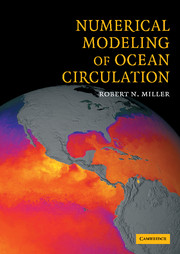4 - Primitive equation models
Published online by Cambridge University Press: 19 February 2010
Summary
Specification of the primitive equation model
The primitive equations, commonly understood as the Navier–Stokes equations in a rotating reference frame, with the vertical momentum equation replaced by the hydrostatic relation, form the basis of the most commonly used models of the ocean on regional to global scales. The flow is generally presumed to be incompressible but stratified; density variations are neglected save in the buoyancy terms. This is known as a shallow Boussinesq approximation. It is much more suitable for the oceans than for the atmosphere.
As in a truly incompressible fluid, there are no exchanges of energy between the flow and the internal energy of any fluid parcel, and a cubic meter of bottom water traveling at 1ms–1 is assumed to have the same momentum as a cubic meter of surface water traveling at the same speed. This has the effect of filtering sound waves, which would otherwise render practical large-scale models impractical.
It is sometimes useful to discard the hydrostatic approximation. This is necessary for the study of the details of deep convection in high latitudes and in some coastal ocean modeling applications. Marshall and co-workers (Marshall et al., 1997a, b) have suggested that nonhydrostatic models may be practical for simulation of the ocean on large scales, given the speed of modern computers. This would have the advantage of a single model for the global circulation, including formation of deep water.
The primitive equations by their nature present a number of obstacles to practical computation. For the most part, practical models differ in the fashion in which they cope with these problems.
Information
- Type
- Chapter
- Information
- Numerical Modeling of Ocean Circulation , pp. 87 - 164Publisher: Cambridge University PressPrint publication year: 2007
